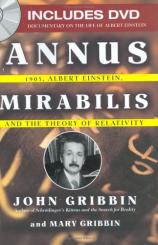Annus Mirabilis: 1905, Albert Einstein, and the Theory Of Relativity
Review
Annus Mirabilis: 1905, Albert Einstein, and the Theory Of Relativity
Albert Einstein's last words are the only secret he left behind.
After a lifetime of scientific achievement the world had not seen
since Galileo and Newton, the twentieth century's greatest thinker
and theorist offered a few words in German and died on April 18,
1955. The nurse at his hospital bedside did not speak the
language.
This little irony followed a career that altered the way we think
about the universe and our place in it. Yet, as John and Mary
Gribbin reveal, what is most breathtaking about Einstein's life is
that his greatest theories were written in four scholarly papers in
just one "miraculous year," 1905. "What made Einstein so special,"
the authors write, "and the annus mirabilis so miraculous, was that
all four pieces of work were produced by the same young man,
working outside the mainstream of scientific life, in his spare
time, while holding down a demanding job…"
Through his youthful conceit and cockiness, Einstein placed himself
outside academia and in a patent office, the last place anyone
would expect a man who would achieve such greatness to work. Born
in Ulm, Germany in 1879 to Jewish parents, young Albert was slow to
learn to speak and was "prone to outbursts of temper," including
one incident when he threw a chair at his violin teacher and chased
her out of the house. He was bored by school but dove into the
Jewish religion with a fervor that burned itself out by the time he
was twelve. He discovered the wonder of science from a friend named
Max Talmey who gave him a geometry book.
Einstein quit high school by being "a know-it-all troublemaker" and
wound up at the Swiss Federal Polytechnic in Zurich. As Einstein
himself often expected, he was recognized for his brilliance and
talent. He became interested in the behavior of light, energy,
matter and the forces that play upon them. Love interests bloomed
for the young scientist, but none so important --- or as the
Gribbins assert, "disruptive" or "problematic" --- as that of
Mileva Maric. While she enthusiastically shared Einstein's
scientific interests, the authors clearly have no respect for
Mileva, who eventually married Einstein in 1903 and gave birth to
his two boys. Albert and Mileva's love was not without scandal ---
their first child, a girl, was delivered prior to their marriage
but was adopted and never heard from again.
Failing to forge a proper reputation to be accepted as a university
professor, Einstein took a job in a patent office and tutored to
support his family. He was a loving father, but not a doting one.
The Gribbins write, "…when he was supposed to be looking
after the baby he might be found with a pipe in his mouth, rocking
the cradle with one hand while writing out calculations on his
ubiquitous notepad with the other."
He was twenty-six when the four famous scientific papers were
written. The first, establishing the reality of light quanta,
earned the Nobel Prize sixteen years later. The second paper was a
doctoral thesis that became his most quoted work. The third proved
the reality of atoms, while the fourth, which was later revised,
offered the theory of relativity: "a complete description of the
relationship between space, time, and matter on a large
scale…" Once published, these essays drew gradual
attention.
The respect of fellow scientists built for Einstein the reputation
he deserved. The attention and attractive offers from universities
around the world finally lured Einstein from his wife and children.
After a breakdown in 1917, he was nursed back to health by his
cousin Elsa with whom he fell in love. She mothered him in a way
that Mileva could not and was his constant companion. Once healthy,
he toured and was treated like a "modern pop star" when he visited
the United States in 1921.
Though the Gribbins' biography of Einstein has its scholarly
moments and is based largely on other biographies and previously
published letters, ANNUS MIRABILIS is a worthy, accessible and, at
times, gripping read. A supplemental, and similar, work not
utilized by the authors but also valuable is EINSTEIN AND OUR WORLD
by David Cassidy. The Gribbins carefully point out that physicist
Einstein did not experiment. He based the foundations of his
theories on the experiments of other scientists.
What made Einstein great? His creativity and his clear status as a
visionary, boldly setting forth theories that would take other
scientists years to prove true. As an iconic "cross between God and
Harpo Marx," Einstein solved the secret of the universe with his
famous equation. And as Einstein himself foretold just five years
before his death, that secret, in the hands of lesser men, could
destroy the world.
Reviewed by Brandon M. Stickney on December 22, 2010
Annus Mirabilis: 1905, Albert Einstein, and the Theory Of Relativity
- Publication Date: March 29, 2005
- Genres: Biography, Nonfiction
- Hardcover: 320 pages
- Publisher: Chamberlain Bros.
- ISBN-10: 1596091444
- ISBN-13: 9781596091443









